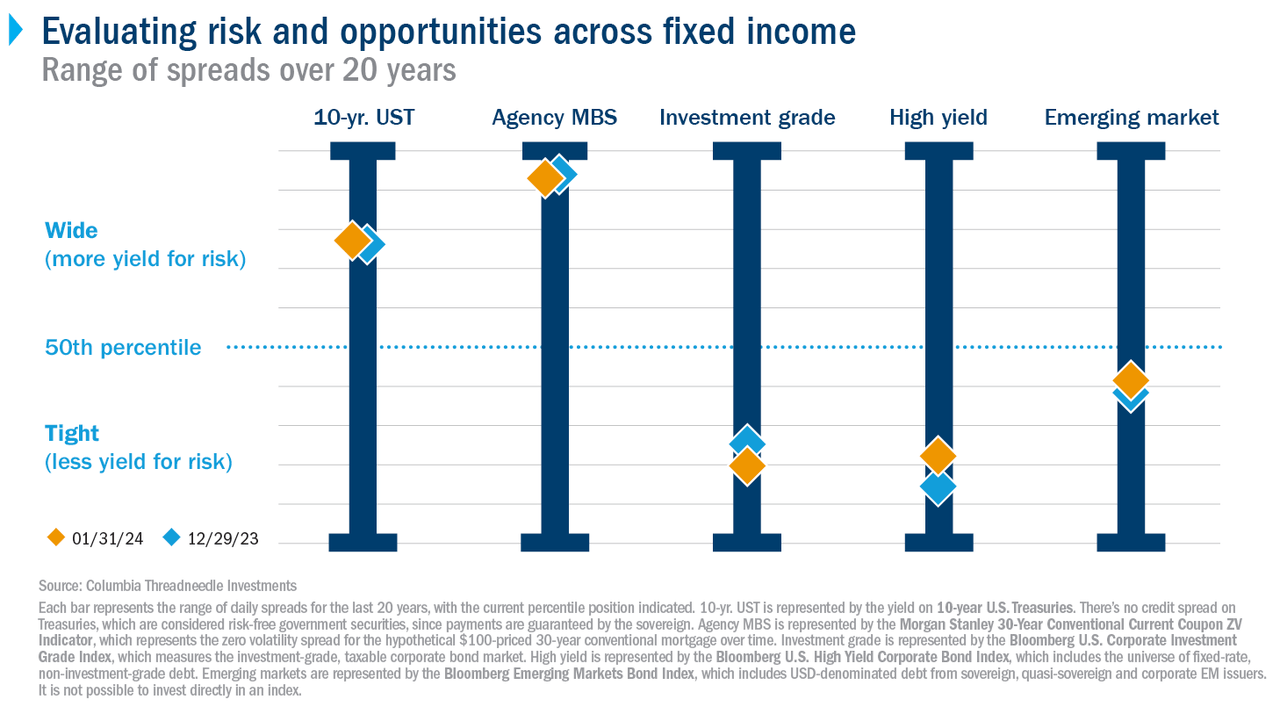Track fixed-income opportunities with this monthly update.
One way to understand where opportunity lies in the broad fixed-income market is to look at credit spreads, which measure the difference in yield between a bond and a risk-free benchmark bond (e.g., U.S. Treasuries) with the same duration.
When looking at opportunities across fixed income, credit spreads indicate how much more an investor is being compensated for taking on the additional risk.
If spreads are above their long-term average, they are referred to as wide; if they’re below their long-term average, they are referred to as tight.
Spreads are continually changing, and those changes are driven by investor sentiment and perceptions of risk.
Our proprietary Fixed-Income Monitor compares current spreads relative to 20 years of history, across fixed-income asset classes, to help investors identify opportunities across fixed-income sectors.
Key takeaways for February 2024
- Positive momentum coming into the new year slowed in January as investors digested firmer than expected economic data.
- Volatility was subdued relative to prior periods. After initially selling off, spreads ended the month essentially flat across credit and securitized assets. Interest rates edged higher during most trading days but ended near their starting levels.
- While current spreads remain tight across many sectors, yields are at multi-year highs, which has reignited demand for high-quality, lower risk income across the fixed-income landscape as the Fed moves towards easing monetary policy.

Learn more about the importance of understanding spreads from Gene Tannuzzo, Global Head of Fixed Income.
Transcript
In the bond market, when we talk about spread product, we’re talking about any bonds that are not the risk-free asset. So in the taxable bond market, we’re talking about any bonds that are not Treasuries or trade at an additional yield relative to Treasuries.
In the municipal bond market, we’re talking about any bonds that are not AAA, general obligation bonds. The primary role of spread products is adding additional yield to a portfolio.
When we look at spreads over a long period of time, if they’re above their long-term average, we might refer to them as wide or cheap. And if they’re more expensive than their long-term average, we might refer to them as rich or tight.
So in general, we’re looking for spread product or opportunities in the bond market where credit spreads are wide or cheap relative to the risks inherent in that security.
Disclosure
Use of products, materials and services available through Columbia Threadneedle Investments may be subject to approval by your home office.
© 2016-2024 Columbia Management Investment Advisers, LLC. All rights reserved.
Investors should consider the investment objectives, risks, charges, and expenses of Columbia Seligman Premium Technology Growth Fund carefully before investing. To obtain the Fund’s most recent periodic reports and other regulatory filings, contact your financial advisor or download reports here. These reports and other filings can also be found on the Securities and Exchange Commission’s EDGAR Database. You should read these reports and other filings carefully before investing.
With respect to mutual funds, ETFs and Tri-Continental Corporation, investors should consider the investment objectives, risks, charges and expenses of a fund carefully before investing. To learn more about this and other important information about each fund, download a free prospectus. The prospectus should be read carefully before investing.
The views expressed are as of the date given, may change as market or other conditions change and may differ from views expressed by other Columbia Management Investment Advisers, LLC (CMIA) associates or affiliates. Actual investments or investment decisions made by CMIA and its affiliates, whether for its own account or on behalf of clients, may not necessarily reflect the views expressed. This information is not intended to provide investment advice and does not take into consideration individual investor circumstances. Investment decisions should always be made based on an investor’s specific financial needs, objectives, goals, time horizon and risk tolerance. Asset classes described may not be appropriate for all investors. Past performance does not guarantee future results, and no forecast should be considered a guarantee either. Since economic and market conditions change frequently, there can be no assurance that the trends described here will continue or that any forecasts are accurate.
Columbia Funds and Columbia Acorn Funds are distributed by Columbia Management Investment Distributors, Inc., member FINRA. Columbia Funds are managed by Columbia Management Investment Advisers, LLC and Columbia Acorn Funds are managed by Columbia Wanger Asset Management, LLC, a subsidiary of Columbia Management Investment Advisers, LLC. ETFs are distributed by ALPS Distributors, Inc., member FINRA, an unaffiliated entity.
Columbia Threadneedle Investments (Columbia Threadneedle) is the global brand name of the Columbia and Threadneedle group of companies.

Original Post
Editor’s Note: The summary bullets for this article were chosen by Seeking Alpha editors.
Read the full article here













